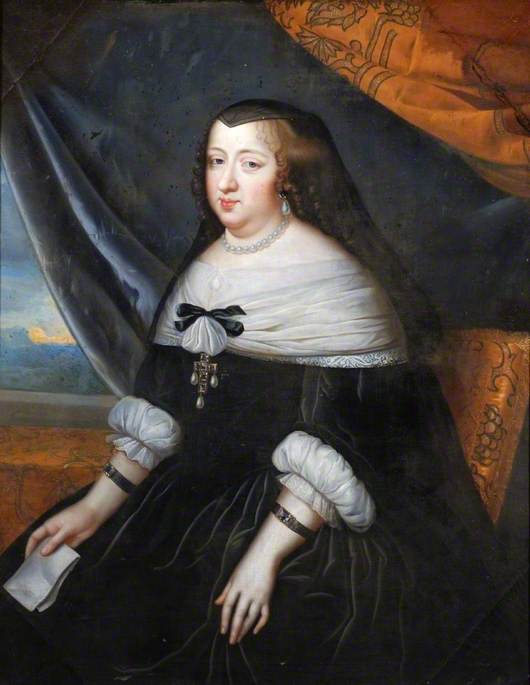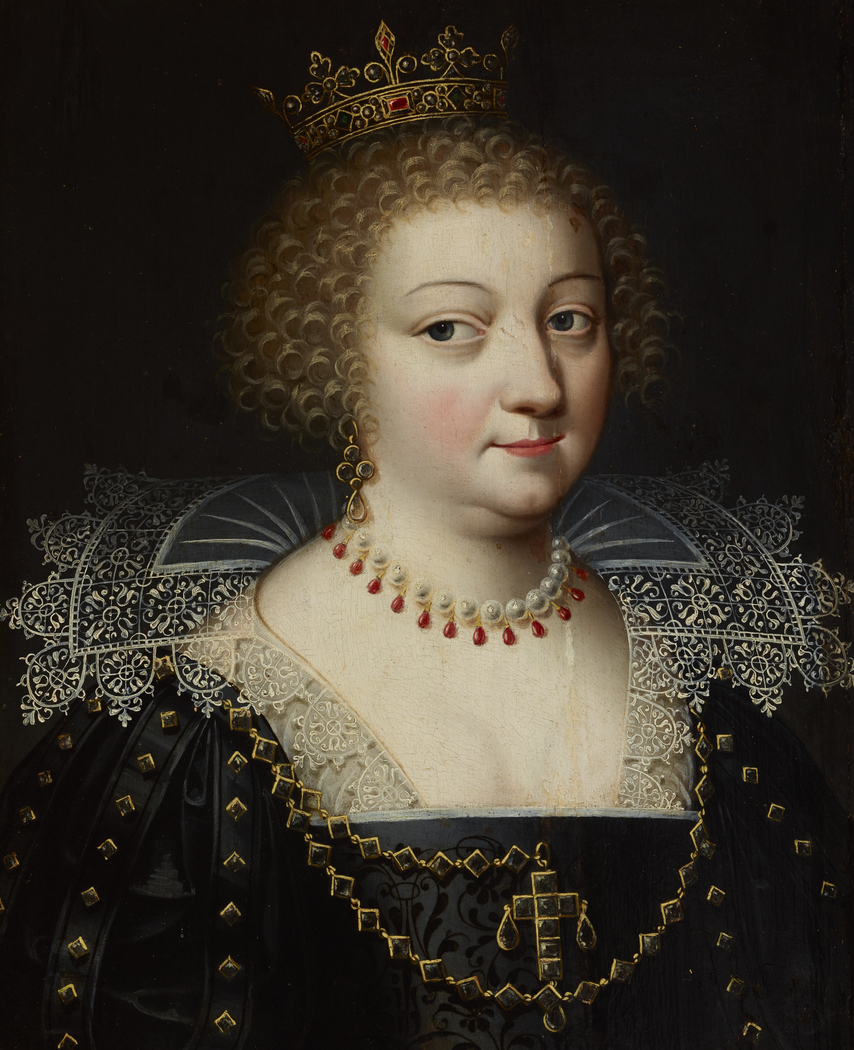Anne of Austria had been queen consort of France for 28 years and regent for her son, Louis XIV, for eight years. Through these years, she had amassed an impressive collection of jewellery. Upon her death on 20 January 1666, an inventory of her belongings was drawn up, as per tradition. This allows us to take a look into the jewellery owned by the late queen mother.
The jewellery was appraised by the duo Pittan and Ballin. However, the pieces found in her inventory does not account for all the jewels she owned. For instance, her wedding jewels were lavish but some do not appear to be amongst those listed in the inventory. The inventory of the jewellery which she brought with her into France spanned over 13 pages alone. To truly show the jewels that Anne of Austria would have had at her disposal, I have included such other jewels as well. The reason for such disparity is the trend which is still prevalent today of restyling gemstones into modern pieces, including melting gold down for new jewellery. This would explain why so little of her original jewellery dowry appear to have been intact at her death.
 |
| Anne as a widow |
Rings
In total, 51 rings were located in her possession
1 ring with brilliants
1 sapphire and diamond ring
2 rings with yellow diamonds
6 rings with large rubies
3 spinel rings
5 rings with smaller rubies
3 turquoise rings
2 sapphire rings
1 topaz ring
2 emerald rings
1 diamond ring with the portrait of Louis XIII
1 ring with the portrait of a saint
2 peridot rings
1 amethyst ring
3 portrait rings depicting Henri IV, Louis XIII and the Infanta Isabella
1 carnelian ring
1 lapis lazuli ring
1 diamond ring with unknown gemstone
In total, her ring collection was estimated to be 30.000 livres worth.
Necklaces
1 pearl necklace - simply referred to as "the Queen's necklace". This would be handed down to both Marie Leszczynska and Marie Antoinette. Consisting of 30 large pearls
1 necklace, estimated at having a total of 300 carats - 5.000 livres
1 long necklace in pure gold, enameled in white, red, green and grey, and set with rubies and diamonds
1 large diamond pendant (likely for the gold necklace)
After she became a widow, Anne reverted to her favourite pieces which appears to have been a set - a semi-parure - of a pearl necklace and a pair of matching pearl earrings. For one, many of her portraits feature her wearing just such a small (but immensely expensive) set.
Earrings
1 pair of diamond earrings with each earring consisting of four large diamonds with smaller diamonds hanging underneath - 50.000 livres
1 pair of earrings consisting of square diamonds with large pear-shaped pearls hanging from the diamonds - 26.000 livres
1 pair of diamond and pearl earrings - 50.000 livres
1 par of earrings of enameled gold set with diamonds
 |
| Design for earrings worn by Anne |
Bracelets
1 bracelet with diamonds and emeralds - 1.500 livres
1 bracelet with green rock crystals and diamonds - 450 livres
1 bracelet with rubies, diamonds and pearls, unknown value
1 bracelet with carnelians, pearls and diamonds - 300 livres
2 bracelets with carnelians and diamonds - 400 livres
2 bracelets with gilded lapis lazuli and diamonds - 300 livres
1 bracelet of pale blue enamel and small diamonds - 100 livres
2 bracelets of horn material - 80 livres
1 jade bracelet - unknown value
1 bracelet with the king's hair - unknown value
1 bracelet of 14 diamonds and golden bows covered in black enamel - 10.000 livres
1 bracelet of 7 large diamonds mounted on jade - 17.500 livres
1 bracelet of 9 large emeralds and 9 diamonds - 4.800 livres
1 bracelet of twelve different gemstones, each surrounded by three smaller diamonds - 5.500 livres
2 bracelets of 14 peridots each, rubies and diamonds - 1.000 livres
A pair of bracelets, one with amethysts and one with diamonds - 1.200 livres
2 bracelets with 13 large rubies each, adorned with diamonds - 20.000 livres
 |
| Anne as Queen of France |
Watches
1 carnelian watch adorned with diamonds and attached to a matching carnelian bracelet - 1100 livres
1 lapis lazuli watch also adorned with diamonds and attachable to one of two matching bracelets
1 watch of turquoise and diamonds
1 watch of blue enamel (likely a match to the bracelet)
1 watch with amethyst, diamonds and emeralds - 1.200 livres
1 watch with amethyst, topaz and diamonds - 1.000 livres
1 watch of filigree - with a matching chain - and adorned with diamonds - 600 livres
1 watch previously belonging to the Spanish ambassador - 100 livres
1 large golden watch - 100 livres
1 small watch, "always worn by the queen" - 100 livres
Being an immensely devout woman, Anne had a penchant for Christian jewels, such as rosaries, cross pendants etc.
Religious jewellery
An emerald cross entirely covered with diamonds - 2.500 livres
A cross with a very large ruby adorned with diamonds - 3.500 livres
A ruby cross with diamonds - 600 livres
A filigree cross covered in yellow diamonds - 2.400 livres
A small sapphire cross with four diamonds - 1.200 livres
A cross with five diamonds - 2.000 livres
A large cross with a centerpiece consisting of a massive lozenge-shaped diamond with three large diamonds hanging beneath - 130.000 livres
Another large cross with a large diamond at its centre, four slightly smaller diamonds and finally four small diamonds - 70.000 livres
A large cross made up of pearls and diamonds - 26.000 livres
A large cross with very large diamonds - estimated at about 250.000 livres
A cross with a crown supported by four diamonds - 5.000 livres
A remarkably colourful cross with diamonds, rubies, topaz, sapphire and emerald - 6.000 livres
Besides these pendants, the queen owned countless rosaries of every imaginable material - from diamonds and gold to chrysolite, turquoise and carnelian. 36 different rosaries were listed in a single inventory which indicates that they were stored at the same place.
Finally, the queen's personal collection included various loose gemstones often of immense value. For instance, Cardinal Mazarin had left her several such pieces in his will, including a very large diamond called the Rose of England and a perfect cabochon from the Far East. Her wedding ring had consisted of a large, square diamond.
Considering the price of some of the items above, it is hardly a surprise that the jewellery which Anne of Austria left to her sons was worth over 1.300.000 livres. They were to be divided between Louis and Philippe, with most pieces going to Philippe. This was Anne's own wish - particularly that Anne's granddaughter through Philippe - was to inherit her jewellery as the king's daughter-in-law would be sufficiently provided for.

























